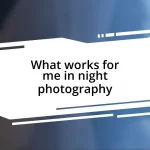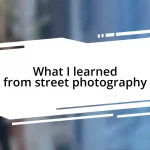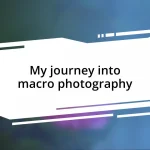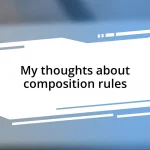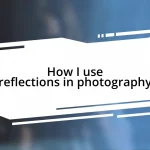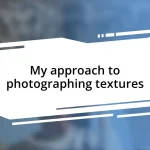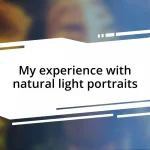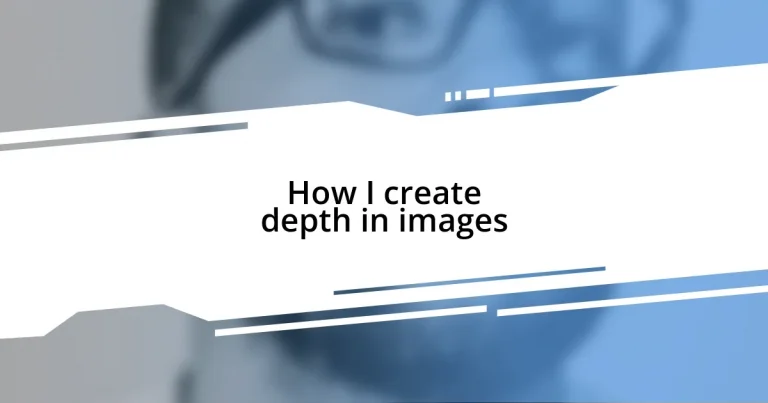Key takeaways:
- Understanding and utilizing depth techniques, such as layering and atmospheric perspective, can enhance the three-dimensional feel of a photograph.
- Incorporating foreground and background elements enriches storytelling and emotional engagement in photography.
- Effective lighting plays a crucial role in creating texture and mood, transforming the viewer’s experience of an image.
- Post-processing adjustments, including contrast, color enhancement, and vignetting, can significantly deepen the emotional resonance of photographs.
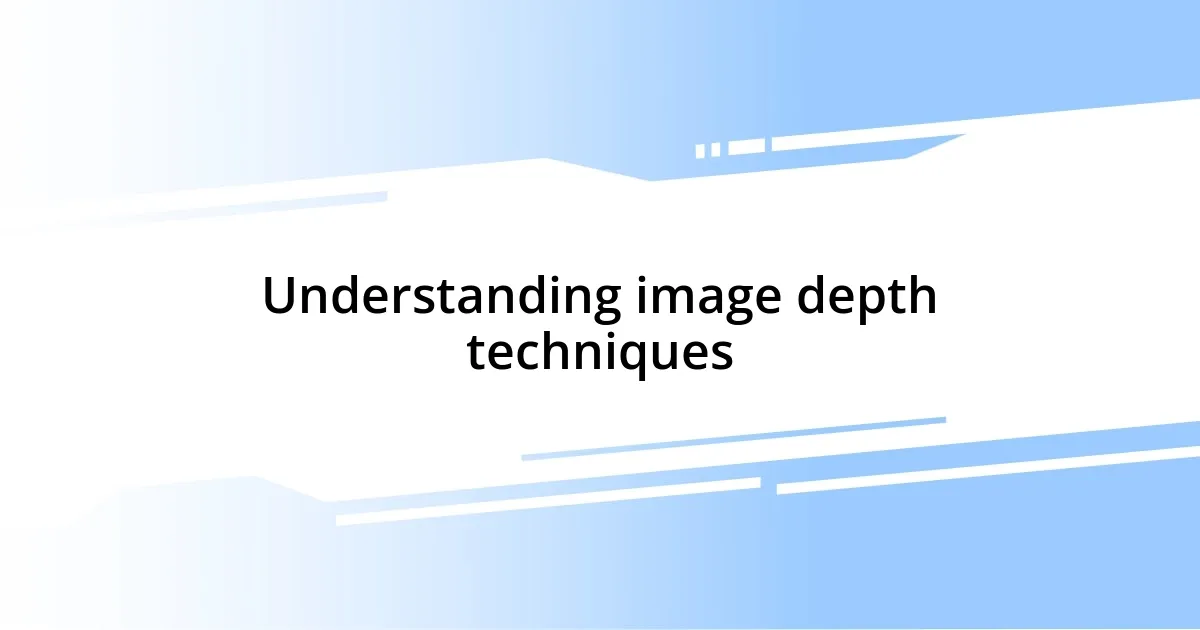
Understanding image depth techniques
I’ve found that understanding image depth techniques can transform a flat photo into something that feels three-dimensional. For example, using techniques like layering and foreground interest creates a natural depth that pulls the viewer into the scene. Have you ever noticed how a well-placed branch in the foreground draws your eyes into a landscape?
One of my favorite methods is utilizing atmospheric perspective; it’s incredible how colors fade and become muted in the distance. I remember capturing a mountain range at sunset, where the vibrant hues of the foreground contrasted beautifully with the softer blues of the distant peaks. That experience taught me that depth isn’t just about physical layering; it’s also about conveying distance and atmosphere emotionally.
Another technique I frequently employ is selective focus, which draws attention to specific subjects while softening the background. It’s almost like creating a personal connection with the viewer, guiding their gaze exactly where I want it. Don’t you think it’s fascinating how a simple adjustment in focus can change the entire mood of an image?
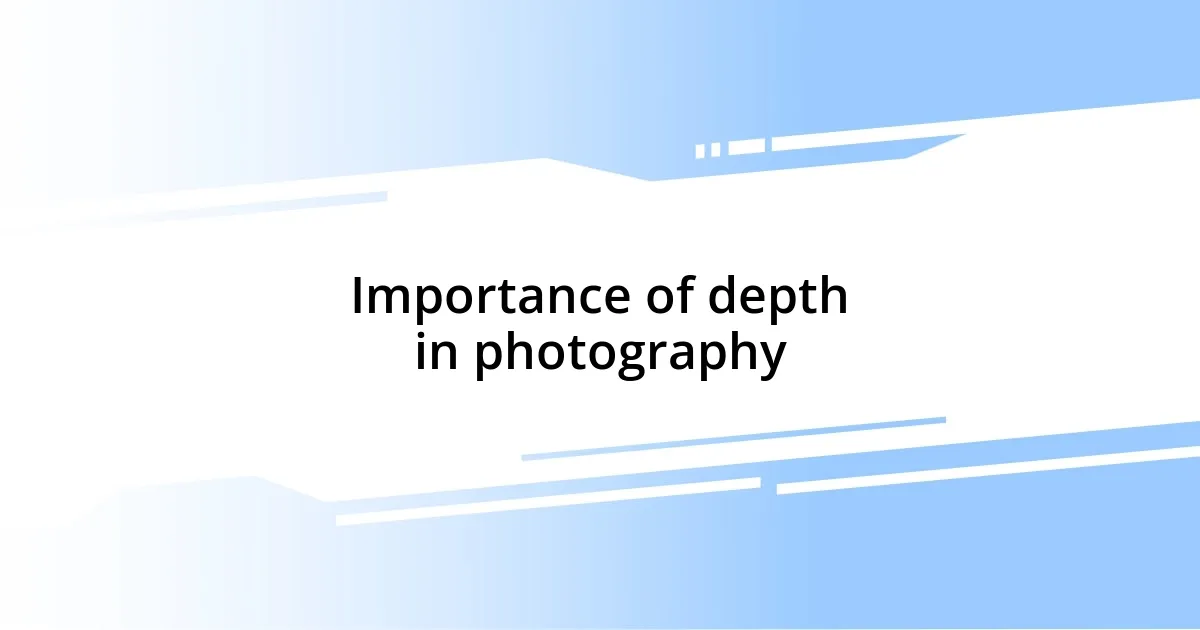
Importance of depth in photography
Depth in photography is crucial because it adds dimension to an otherwise flat image. Without depth, photos can sometimes feel lifeless or uninviting. I remember one occasion when I focused solely on depth while shooting a bustling cityscape. The layers of buildings, people, and street elements converged to create a sense of vibrancy that invited viewers to explore the scene further.
In my opinion, depth also plays a significant role in storytelling. When I capture elements of foreground, middle ground, and background, I can weave a narrative that encourages the viewer to embark on a visual journey. I vividly recall photographing a local market; by incorporating vibrantly colored stalls in the front, I could effectively communicate the energy of the atmosphere, allowing viewers to almost hear the chatter and smell the spices.
Ultimately, depth enhances emotional engagement in photography. A photo with depth can evoke feelings of wonder or nostalgia, making it relatable. For instance, I once shot a serene beach scene with a pier stretching into the distance, utilizing a shallow depth of field. The resulting image not only highlighted the gentle waves but also instilled a sense of calm within me, which I hoped to convey to those who viewed it.
| Aspect | Importance |
|---|---|
| Visual Interest | Creates engaging compositions that capture attention. |
| Storytelling | Woven narratives allowing viewers to connect with the image. |
| Emotional Engagement | Evokes deeper feelings and reactions from the audience. |
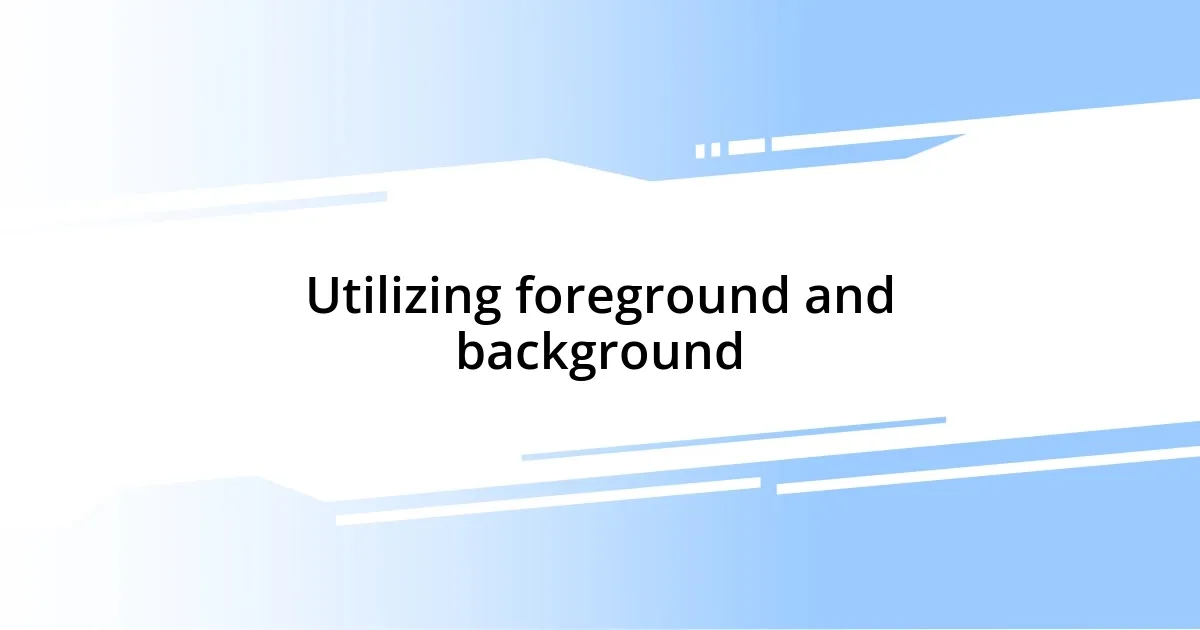
Utilizing foreground and background
Utilizing both the foreground and background in my photography has consistently enhanced the depth and dimension of my images. I often play with elements in the foreground that add intrigue while simultaneously allowing the background to contribute to the overall narrative. For instance, I distinctly remember a morning shoot at a foggy lake—my focal point was a cluster of reeds close to the shore, which beautifully framed the ghostly silhouettes of distant trees. This layering not only drew the viewer’s eye but also created a sense of tranquility, inviting them to explore each layer of the scene.
- Foreground Elements: These can add interest and context, making the photo feel more immersive. A closer object can lead the viewer into the image.
- Background Details: They provide context and scale, enhancing the story. Often, subtle details back there can evoke memories or emotions, creating a richer experience.
- Depth of Field: Varying focus between foreground and background can emphasize the subject in the front while blurring distractions, steering the viewer’s attention naturally.
When I consider the relationship between foreground and background, I truly appreciate how they work together to frame a scene. I once photographed an old barn nestled in a valley, using wildflowers in the foreground to lead into the barn and the mountains behind it. This deliberate composition made the image feel alive, as if you could step right into the moment. The colors and textures of the flowers contrasted nicely with the rustic wood of the barn and the vast mountains looming in the background, creating a visual depth that was both inviting and expansive.

Effective use of lighting
Lighting can truly transform an image, adding layers and dimension that deepen a viewer’s experience. I remember a time shooting in early morning light, the soft rays perfectly casting an ethereal glow on the dewdrops hanging from leaves. That gentle illumination not only highlighted the details but also created an inviting warmth, drawing the viewer into the moment.
In my experience, the direction of light can significantly alter the mood and depth of a photograph. When I experiment with side lighting—where light hits the subject at an angle—I often find that it enhances textures and shapes, creating captivating shadows that add drama. One particular shot that stands out was a close-up of a weathered tree trunk; the play of light and shadow revealed intricate patterns that told a story of resilience. Isn’t it fascinating how something as simple as lighting can evoke such depth?
Playing with harsh lighting can also yield striking results. I once took a portrait under the mid-afternoon sun, embracing the high contrast between light and dark. While some might shy away from such conditions, I found that the bold shadows and bright highlights added an edgy feel to the image. It ignited a certain energy that reflected the personality of my subject, inviting viewers to engage with the photograph on a deeper level. Have you ever tried capturing a moment with such intensity? The reaction can be electrifying!
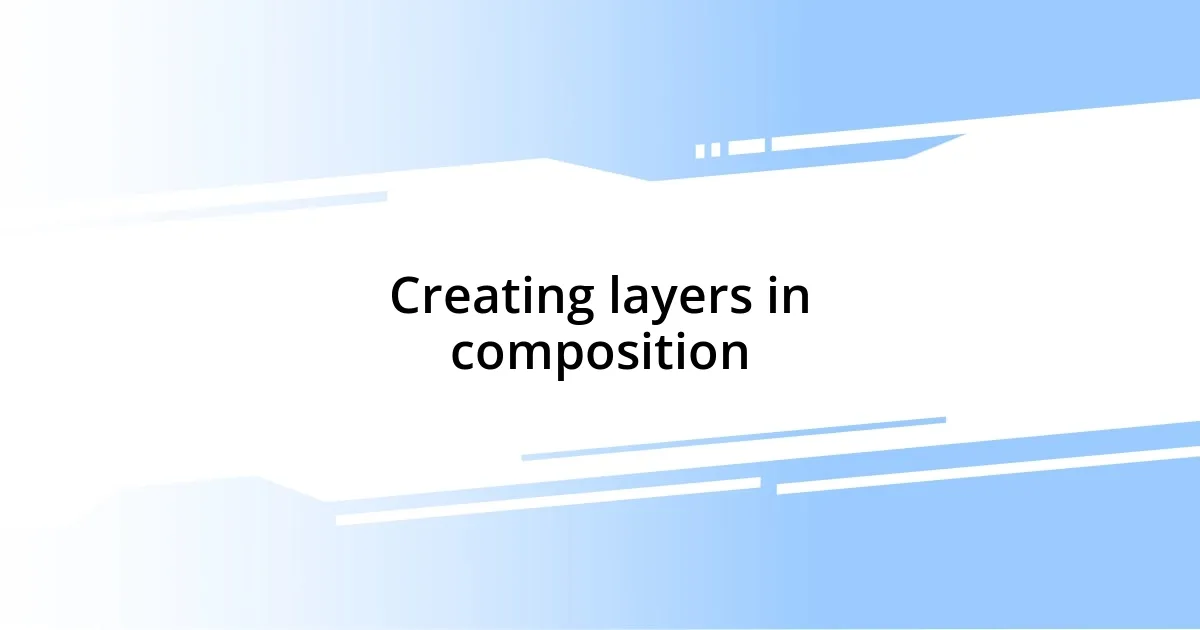
Creating layers in composition
Creating layers in a composition can be one of the most rewarding aspects of photography. I often find that incorporating various elements, such as shapes and textures, adds dimension to my images. For instance, while exploring an abandoned factory, I positioned myself to include peeling paint on the walls and broken windows in the foreground. This not only emphasized the decay but also evoked a sense of nostalgia, inviting viewers to ponder the stories behind the remnants.
There’s something magical about leading the viewer’s eye through an image using layers. During a recent hike, I captured a majestic mountain scene where I placed a vibrant wildflower patch in the foreground. The flowers danced with color, gently guiding the eye toward the snow-capped peaks in the distance. It was as if the flowers were a bridge, connecting two vast worlds. Have you ever noticed how a carefully placed element can transform your perception of depth?
I’ve learned that incorporating varying heights and depths within a composition adds richness to the visual narrative. One memorable experience was during a cityscape shoot at sunset; I shot through a narrow alley framed by tall buildings, which allowed the warm glow of the setting sun to filter through. By including intriguing textures like brick and glass in the frame, I created a lively scene that captured the essence of urban life. The multiple layers drew viewers in, prompting them to explore the contrasting elements and discover the unexpected beauty in the bustling city around them.
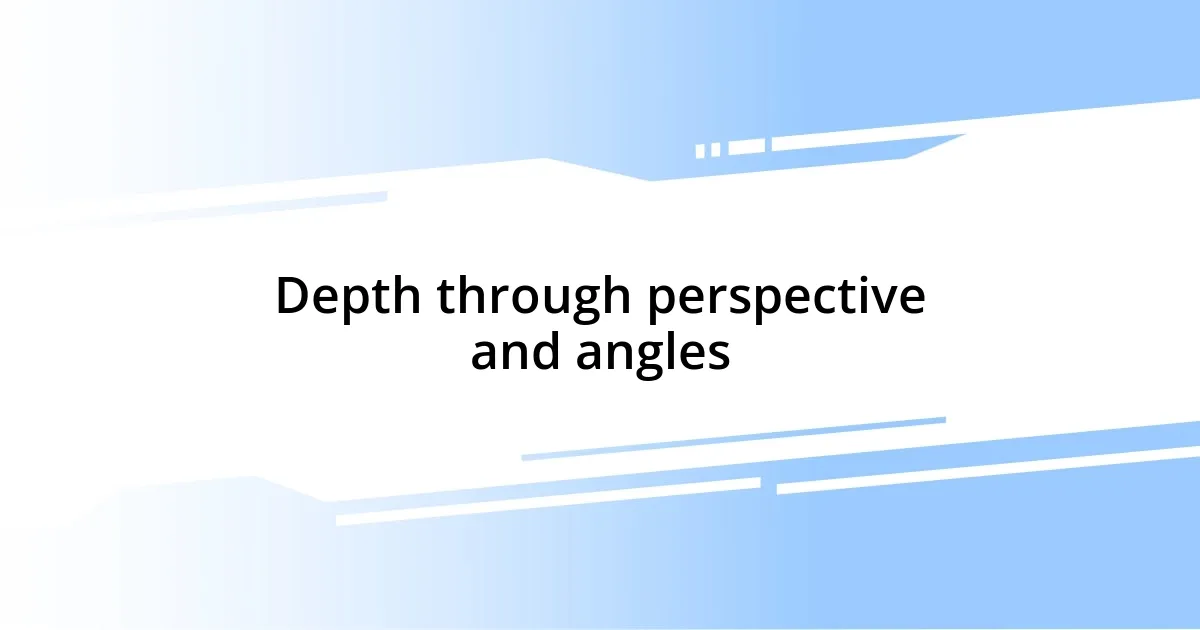
Depth through perspective and angles
Finding depth in images through perspective and angles can truly elevate a photograph. I remember a time when I knelt low to the ground while capturing a landscape, which dramatically changed the scene’s feel. By positioning the camera at that angle, I was able to emphasize the foreground elements—like the textured grass and wildflowers—drawing the viewer’s eye into the frame and creating a sense of immersion. Have you ever tried positioning yourself differently? The results can be stunning!
One technique I enjoy is utilizing leading lines, which can guide the viewer’s gaze through a photograph. During a coastal shoot, I discovered a winding path that led toward the horizon. By framing the image to include that path, it not only created a sense of journey but also emphasized the vastness of the sea beyond. It made me reflect on how a simple angle can shift the entire narrative of an image. What stories do your photographs tell through the angles you choose?
Angles also play a pivotal role in conveying emotion. I once captured a candid moment of a child playing in a puddle from a high vantage point, looking down. This perspective magnified the innocence and joy, making the viewer feel as though they were savoring that moment of wonder alongside the child. Isn’t it remarkable how a slight shift in perspective can unlock a new depth of feeling and connection?

Post-processing for enhanced depth
Post-processing plays a crucial role in enhancing depth in images, allowing me to refine the layers I’ve captured. I often utilize tools like Adobe Lightroom or Photoshop to adjust the contrast and clarity. Recently, I edited a photo of a misty forest where I intentionally boosted the shadows and highlights to bring out the intricate textures of leaves and tree bark. This shift not only added dimension but also evoked a sense of mystery—didn’t you feel like you could step into that serene world?
Another technique I find effective is employing selective color adjustments during post-processing. I remember working on an image of a sunset over a lake, where the foreground was rich with foliage. By enhancing the greens and oranges slightly, I managed to create a vibrant contrast with the cooler tones of the water and sky. This layering of colors worked wonders, as it drew the viewer’s eye through the scene. Have you ever experimented with color shifts to deepen the emotional resonance of your photos?
Lastly, I love adding vignettes in post-processing to focus attention on the subject. On one occasion, I had an intimate portrait of a musician playing guitar outdoors, surrounded by swaying trees. By subtly darkening the edges of the photo, I highlighted the musician while creating an enveloping warmth around him. This technique not only directed the viewer’s focus but also imparted a sense of closeness to the moment. Isn’t it incredible how a simple edit can elevate both the depth and emotion of an image?
